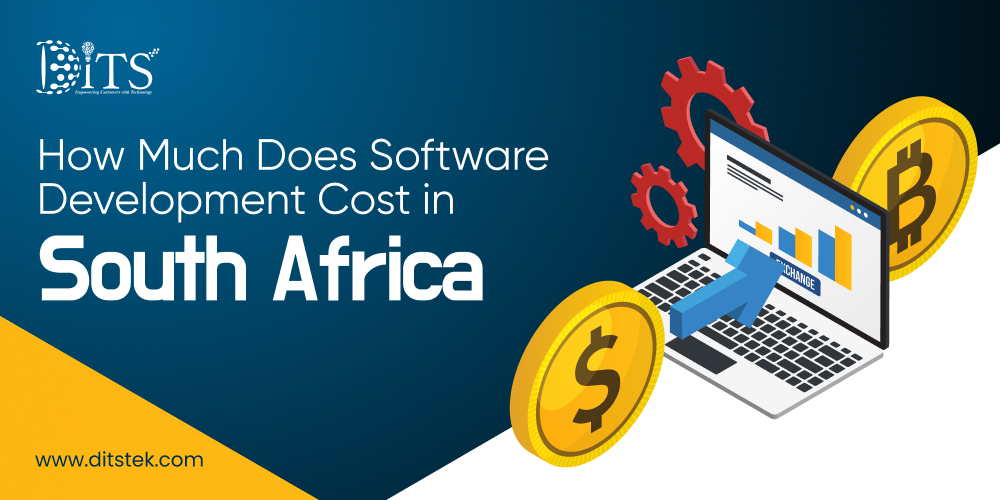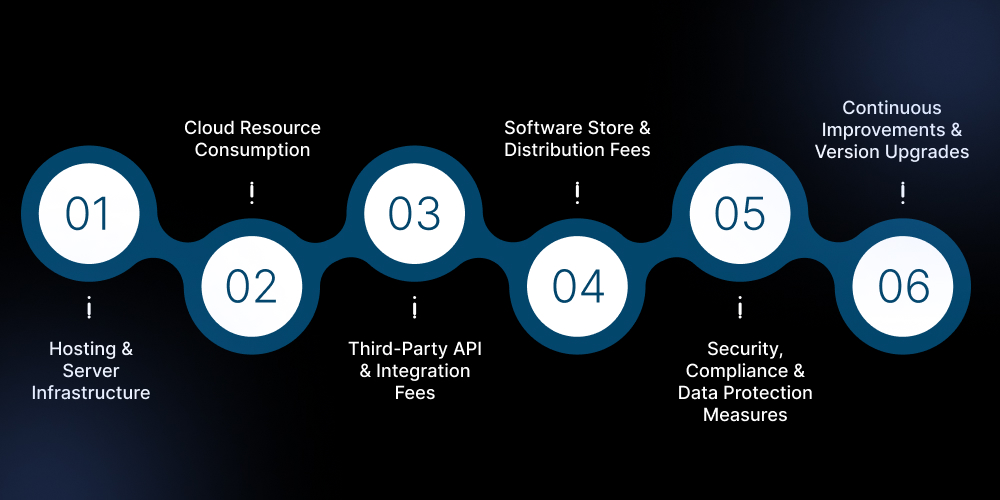How Much Does Software Development Cost in South Africa?
Ditstek Blogs
Software are becoming necessary for businesses in South Africa. They’ve quietly become the way for companies to simplify work, attract customers, and keep services running. Software is everywhere: from small retailers offering quick ordering software to large enterprises rolling out tools for field teams. With this shift, more businesses are trying to figure out the real cost to develop software in South Africa, and the factors by which the cost varies.
The software development cost isn’t the same for every business. Some software takes a few weeks and a modest budget to develop, while others may need months of planning, design, and development. Moreover, things like features, integrations, design complexity, and the overall vision also have an impact on the cost of development.
South African companies are now looking for more clarity - a clearer picture before they set budgets or pitch ideas internally. That’s exactly where this guide will help businesses plan their software development budget. They will get a practical sense of what influences the cost of developing software in South Africa, and what matters for making the right decisions.
Plan your software development budget with clarity. Book a cost consultation with our team today.
How Much Does It Cost to Develop a Software in South Africa?
When talking about the cost to develop software in South Africa, the numbers shift depending on how simple or ambitious the idea is. A small software with a few screens may fall into a lighter budget bracket, while something with dashboards, user accounts, and integrations easily moves into a higher range.
- Basic software, the kind that offers a handful of features and clean navigation, usually sits on the lower end. They don’t take months to build, and they don’t demand complex architecture.
- Mid-level software lands somewhere in the middle. These often include user profiles, notifications, and data syncing, so the work becomes more detailed.
- And then you get the advanced builds. Enterprise-grade projects, scheduling tools, or anything that relies on deep workflows take more time and more hands.
Another thing companies often weigh is whether to work with local teams or outsource abroad. Many prefer local development because it’s easier to talk through ideas, align on timelines, and avoid big cultural gaps. But there’s a catch: rates differ across regions, and sometimes outsourcing looks cheaper upfront, but the revisions and misalignment push the project longer.
The cost of developing software in South Africa isn’t just about numbers, but about understanding which direction fits their goals.
Factors Influencing Software Development Cost In South Africa

Software Complexity
Basic software handles simple functions and fewer screens. Mid-level software introduces accounts, data syncing, and smoother flows. Enterprise software operates on the high end: multiple roles, dashboards, and complex logic push the cost further as the system grows.
Features And Functionalities
User login, GPS, chat, payment gateways, push alerts, admin dashboards, and external integrations each add to the workload. Even a small change can impact the software’s structure.
Platform Choice
South African companies choose between iOS, Android, or cross-platform depending on their market goals and long-term plans. Each route affects the budget differently.
UI/UX Design
Basic layouts cost less, while custom screens, interactive journeys, and branded experiences take more design time.
Backend Development And APIs
Software that stores data, processes user actions, or connects to business systems needs a solid backend. The more complex the workflows, the higher the cost.
Developer Expertise And Team Composition
Freelancers may offer lower rates but limited capacity. A structured software development company South Africa provides processes, specialists, and predictable timelines. This becomes especially important for organizations exploring broader initiatives.
Not sure where your project fits cost-wise? Get a tailored estimate based on your goals and features.
Estimated Cost Breakdown by Software Type in South Africa

Different industries require different levels of depth, and that’s why software costs vary so much. A simple tool for bookings behaves nothing like a fintech wallet or a delivery platform with live tracking. Each category carries its own challenges, and that shows up directly in the budget.
On-Demand Software
On-demand software usually fall into the mid to higher range. Software needs real-time updates, driver or service-provider panels, customer accounts, and smooth communication between all sides. Even small changes can influence the flow, so development time adds up.
E-Commerce Software
E-commerce Software can start on the lighter side, but quickly scale depending on features. Product catalogues, carts, payment options, and order management are the basics. Add personalized recommendations or custom workflows, and the cost rises. South African retailers often request integrations with existing systems, which adds more backend work.
Marketplace Software
Marketplace Software sit a bit higher. Two user types, multiple interactions, and the need for a reliable admin dashboard all require extra planning. These platforms handle more data, which impacts the structure behind the scenes.
Healthcare Software
Healthcare Software brings strict handling of sensitive information. Software tools and simple record-keeping cost less, but anything involving remote monitoring or workflow automation leans into a higher bracket. This is also where some companies introduce specialized integrations like IoT software development, depending on their operational needs.
Fintech Software
Fintech Software usually falls on the upper end because security becomes a major focus. Even small payment or transfer features demand rigorous testing and compliance steps.
Logistics & Fleet Software
Logistics and fleet Software cover tracking, route planning, and reporting. These rely heavily on GPS and data processing, which extends development hours.
Edtech Software
Simple learning tools sit on the lower end. Software with assessments, video content, or separate user roles costs more. Some businesses also extend capabilities with solutions like IoT software development when physical devices are involved.
Cost Breakdown of Software Development Stages in South Africa

Building software is a multi-layered process, and each stage contributes a defined portion to the total investment. Some phases require rapid iterations, while others demand deep technical focus. Together, they shape the overall timeline, complexity, and cost of the final product.
1. Research & Planning (5–10% of total cost)
This stage lays the strategic foundation of the project. Teams define requirements, user journeys, feature priorities, technical constraints, and the complete development roadmap. Costs remain moderate due to shorter timelines, but the impact is huge. Strong planning prevents scope creep and avoids expensive rework later.
2. UI/UX Design (10–20% of total cost)
Designers translate ideas into wireframes, user flows, interface layouts, and high-fidelity screens. Simple UI keeps costs low, while bespoke visuals, animations, accessibility features, and branded micro-details increase the design investment. The more immersive the experience, the larger this slice of the budget becomes.
3. Software (Front-End) Development (20–30% of total cost)
This is where user-facing screens and interactions come to life. Developers code layouts, navigation, dashboards, forms, animations, and the entire front-end logic. Costs depend on the number of screens, the complexity of interactions, and the technologies chosen. Rich, dynamic interfaces generally require more development hours.
4. Backend Development (25–35% of total cost)
The backend powers everything behind the scenes from data handling, authentication, workflows, APIs, analytics, admin dashboards, to third-party integrations. Enterprise-grade software, multi-role systems, and AI-powered logic all push this cost upward. This phase often becomes the most expensive for data-heavy or workflow-intensive applications.
5. Testing & QA (10–15% of total cost)
QA engineers validate performance, security, responsiveness, and device compatibility. They test features across browsers, environments, and edge cases. The broader the testing matrix, and the more complex the software, the higher the quality assurance cost. DITS offers thorough QA testing services which helps companies prevents post-launch failures and improves long-term stability.
6. Deployment (2–5% of total cost)
Releasing the software involves preparing builds, configuring servers, meeting platform guidelines, and ensuring the final version is production-ready. This stage is predictable and usually represents a small percentage of the overall budget.
7. Support & Maintenance (10–20% recurring – monthly or quarterly)
Post-launch updates, bug fixes, feature upgrades, security patches, optimization, and server maintenance are essential to keep the software performing smoothly. Many companies also use this stage to roll out AI-driven enhancements such as automation layers, predictive analytics, and smart user experiences.
Turn your idea into a scalable software product. Connect with DITS for a detailed proposal and timeline.
Software Development Stages & Estimated Costs (USD)
DITS delivers full-cycle software development services designed for businesses that want scalable, secure, and future-ready digital solutions. Our team of senior engineers, architects, and designers brings deep technical expertise across web, mobile, AI, and enterprise systems.
We offer flexible engagement models, and our development services start at $22/hr approximately R380/hr giving South African businesses access to premium global talent at an efficient and competitive rate.
Whether you’re building a new product, modernizing legacy workflows, or adding AI capabilities, our team ensures high-quality delivery, transparent communication, and predictable outcomes.
| Stage | Approximate Cost | |
| Research & Planning | R 34,000 – R 103,000 | Discovery workshops, requirement modeling, feature mapping, user flows, and technical architecture planning. |
| UI/UX Design | R 52,000 – R 207,000 | Wireframes, interface layouts, interactive prototypes, visual styling, and user-centric experience design. |
| Front-End Development | R 138,000 – R 380,000 | Coding screens, user interactions, dashboards, form logic, animations, and all user-facing workflows. |
| Backend Development | R 172,000 – R 483,000 | Database setup, API development, role management, authentication, admin portals, business logic, and data workflows. |
| Testing & QA | R 52,000 – R 155,000 | Bug identification, device/browser testing, performance validation, integration testing, and usability checks. |
| Deployment | R 17,000 – R 52,000 | Preparing production builds, configuring servers, meeting platform requirements, and publishing stable releases. |
| Support & Maintenance (Monthly) | R 10,400 – R 34,500 | Routine monitoring, performance optimization, updates, security patches, bug fixes, and feature iteration. |
Hidden Software Development Costs in South Africa

Even with a solid development budget, additional expenses tend to surface as the project scales. These aren’t necessarily large, but they can influence timelines, performance, and long-term sustainability. Being aware of them upfront helps avoid last-minute overruns and ensures a smoother launch, and also determines exactly how much does it cost to hire software developers for app development.
1. Hosting & Server Infrastructure
Every custom software product needs reliable hosting to store data, run backend logic, and support user traffic. Costs depend on server capacity, uptime SLAs, and performance requirements. Lightweight software can run on basic hosting, but data-heavy or real-time systems require more robust infrastructure, which increases monthly expenses.
2. Cloud Resource Consumption
Modern software often relies on cloud components such as file storage, AI services, background jobs, analytics engines, or scalable databases. These services are billed based on usage, making costs grow as user activity increases. Initial expenses may seem low, but real-world traffic typically elevates consumption after launch.
3. Third-Party API & Integration Fees
If the software uses payment gateways, SMS/OTP systems, email delivery providers, geolocation tools, or verification services, each may charge per request, per transaction, or per active user. A single integration, like high-volume notifications or transactional payments, can significantly impact monthly operational costs.
4. Software Store & Distribution Fees
When distributing applications, there are platform-specific costs: Google Play requires a one-time registration fee, while Apple charges an annual developer account subscription. These costs are minor but essential for long-term software deployment and updates.
5. Security, Compliance & Data Protection Measures
Handling personal, financial, or location-based data often requires advanced security implementations. Encryption layers, secure storage, compliance with POPIA or GDPR, penetration testing, and audit trails add technical overhead. These security enhancements require additional development hours and specialized expertise.
6. Continuous Improvements & Version Upgrades
Software evolves over time—OS updates, browser changes, new device types, and shifting user expectations all require ongoing updates. Routine enhancements, bug fixes, refactoring, and feature expansions become part of the long-term budget. While each update may be small, the cumulative maintenance cost is constant.
How to Reduce Software Development Costs Without Compromising Quality
South African businesses often want to balance budget and performance, and the good news is that it’s completely doable with the right software approach. A few smart decisions early on can save significant time and money later.
Start With MVP
An MVP helps companies launch a smaller, functional version first. It cuts unnecessary features, speeds up development, and lets real users guide what should come next. Getting the MVP development services from an experienced development partner like DITS helps companies keep things focused and structured.
Prioritize Features Based On Business Goals
Not all features matter in the beginning. Some drive revenue, while others simply improve efficiency. A clear priority list prevents teams from spending time on things that won’t impact early success. It also simplifies the software for users, which is a bonus.
Use Cross-Platform Development Wisely
Cross-platform works when the software’s design and performance expectations fit the model. It reduces development time because a single codebase serves both iOS and Android. But if the software relies on hardware-specific functions or heavy customization, native routes may still be better.
Work With Experienced Teams
The right team doesn’t just code, but it guides, refines, and help businesses avoid unnecessary rebuilds. Experienced developers spot gaps early, suggest alternatives, and deliver cleaner results. For companies with long-term digital goals: whether that’s automation or modernization - this makes a big difference.
Why Choose DITS for Software Development In South Africa
Choosing the right partner often decides whether a software becomes a long-term asset or a constant work-in-progress.
DITS has worked on projects across different industries, so the team understands the mix of speed, reliability, and practicality that local businesses look for.
South African organizations deal with unique challenges: from varied device usage to regional market habits. The team plans and designs with that context in mind, which means fewer surprises during development and a smoother rollout.
DITS works with modern frameworks, strong architectures, and stable deployment methods. The team also uses AI internally for software development, code quality, testing, and customization. And when the project requires intelligence built into the product itself, AI becomes part of the solution.
From the first workshop to post-launch maintenance, DITS handles the entire journey. Planning, design, development, testing, improvements: everything stays within a single workflow.
Working with the right partner shapes how confidently a business can move forward with their projects.
Ready to modernize your business systems? Let’s map your project, scope, and development roadmap.
Conclusion
Understanding the cost to develop software in South Africa helps companies plan smarter and build confidently. Costs shift based on features, integrations, and long-term goals, but once the scope is clear, budgeting becomes far easier.
South African companies are investing more in Software because they streamline operations, open new revenue channels, and modernize how teams work. A well-planned build is an investment in the organization’s future.
DITS supports businesses throughout this journey with modern technology, AI-enhanced development methods, and full-cycle delivery. Whether a company needs a simple tool or a more advanced system supported by best backend technologies for Software, the focus stays on long-term value and smooth scalability.
FAQs
How Long Does It Take To Develop Custom Software in South Africa?
Timelines vary based on complexity, feature depth, and integrations. A small, single-function software product can be built in 6–10 weeks, while medium-complexity systems with dashboards, APIs, and role-based access typically take 4–7 months. Enterprise-grade platforms integrating internal systems, automation layers, or multi-module workflows can extend further. A well-defined scope and structured planning phase always help shorten the development cycle.
What Is the Minimum Budget for Software Development?
For South African businesses, entry-level custom software usually starts around $30,000 – $90,000, covering simple features and core functionality. Software that requires payments, authentication, GPS, analytics, or admin controls often exceeds this range. As soon as the system connects to business workflows or requires automation, integrations, or scalability, the budget increases naturally.
Do South African Development Teams Charge Hourly or Per Project?
Both pricing models are used. Hourly rates are common for small tasks, upgrades, bug fixes, or ongoing support. Fixed project pricing is preferred for full builds with clearly defined scope, milestones, and deliverables. Experienced software development teams typically provide structured estimates, offering greater transparency on cost, timeline, and technical requirements from the start.
How Much Does Software Maintenance Cost Per Month?
Most custom software products require monthly maintenance budgets ranging from $450 – $1,400, depending on server usage, updates, user load, and new feature rollouts. Systems connected to internal operations or built with advanced automation may need higher provisioning. Many businesses also allocate additional funds for continuous enhancements, performance optimization, and AI-driven improvements.

Dinesh Thakur
21+ years of IT software development experience in different domains like Business Automation, Healthcare, Retail, Workflow automation, Transportation and logistics, Compliance, Risk Mitigation, POS, etc. Hands-on experience in dealing with overseas clients and providing them with an apt solution to their business needs.
Recent Posts
Get in touch










 Calgary | Edmonton | Vancouver | Toronto
Calgary | Edmonton | Vancouver | Toronto Marriott Downtown Hotel | Calgary
Marriott Downtown Hotel | Calgary